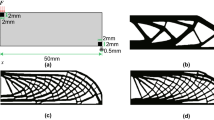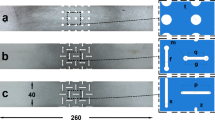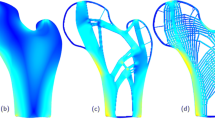Abstract
Among various types of auxetic metamaterials, the perforated materials with peanut-shaped pores exhibit numerous advantages such as simple fabrication, high load-bearing capability, low stress-concentration level and flexibly tunable mechanical properties, and thus they have received much attention recently. However, one challenging is to make a high-efficient and reversible design of such metamaterials to meet diverse auxetic requirements, without the need to model them through conventional physics- or rule-based methods in time-consuming and case-by-case manner. In this study, a data-driven countermeasure is introduced by coupling back-propagation neural network (BPNN) and genetic algorithm (GA). Firstly, a dataset including microstructure-property pairs is prepared to train BPNN to determine the hidden logic mapping relationship from microstructural parameters to Poisson ratio. Then, GA is employed to optimize the mapping relationship to find the corresponding optimal solutions of microstructural parameters meeting the target Poisson’s ratio. The efficiency and accuracy of specific optimal designs is verified by the tensile experiment and finite element simulation. Subsequently, more optimal solutions corresponding to positive, zero or negative Poisson’s ratios are achieved under constrained/unconstrained conditions to accelerate the design of auxetic metamaterials by this interdisciplinary tool in which the auxetic characteristics and artificial intelligence are interconnected mutually.













Similar content being viewed by others
References
Agrawal, G., Gupta, A., Chowdhury, R., Chakrabarti, A.: Robust topology optimization of negative Poisson’s ratio metamaterials under material uncertainty. Finite Elem. Anal. Des. 198, 103649 (2022)
Bertoldi, K., Reis, P.M., Willshaw, S., Mullin, T.: Negative Poisson’s ratio behavior induced by an elastic instability. Adv. Mater. 22, 361–366 (2010)
Butler, K.T., Davies, D.W., Cartwright, H., Isayev, O., Walsh, A.: Machine learning for molecular and materials science. Nature 559, 547–555 (2018)
Chen, J., Hu, S., Zhu, S., Li, T.: Metamaterials: from fundamental physics to intelligent design. Interdisc. Mater. (2022)
Du, G., Bu, L., Hou, Q., Zhou, J., Lu, B.: Prediction of the compressive strength of high-performance self-compacting concrete by an ultrasonic-rebound method based on a GA-BP neural network. PLoS ONE 16, 0250795 (2021)
Feng, W., Yang, S.: Thermomechanical processing optimization for 304 austenitic stainless steel using artificial neural network and genetic algorithm. Appl. Phys. A 122, 1018 (2016)
He, L., Guo, H., Jin, Y., Zhuang, X., Rabczuk, T., Li, Y.: Machine-learning-driven on-demand design of phononic beams. Sci. China Phys. Mech. Astrono. 65, 1–12 (2021a)
He, L., Wen, Z., Jin, Y., Torrent, D., Zhuang, X., Rabczuk, T.: Inverse design of topological metaplates for flexural waves with machine learning. Mater. Des. 199, 109390 (2021b)
Jia, J., Hu, J., Wang, Y., Wu, S., Long, K.: Structural topology optimization with positive and negative Poisson’s ratio materials. Eng. Comput. 37, 1805–1822 (2020)
Jiang, Y., Liu, Z.Y., Matsuhisa, N., Qi, D.P., Leow, W.R., Yang, H., Yu, J.C., Chen, G., Liu, Y.Q., Wan, C.J., Liu, Z.J., Chen, X.D.: Auxetic mechanical metamaterials to enhance sensitivity of stretchable strain sensors. Adv. Mater. 30, 1706589 (2018)
Jin, Y., He, L., Wen, Z., Mortazavi, B., Guo, H., Torrent, D., Djafari-Rouhani, B., Rabczuk, T., Zhuang, X., Li, Y.: Intelligent on-demand design of phononic metamaterials. Nanophotonics 11, 439–460 (2022)
Lakes, R.: Foam structures with a negative Poisson’s ratio. Science 235, 1038–1040 (1987)
Lakes, R.S.: Negative-Poisson's-ratio materials: auxetic solids. Annu. Rev. Mater. Res. 47, 63–81 (2017)
Lakes, R., Wojciechowski, K.: Negative compressibility, negative Poisson’s ratio, and stability. Phys. Status Solidi B 245, 545–551 (2008)
Li, D., Dong, L., Yin, J., Lakes, R.S.: Negative Poisson’s ratio in 2D Voronoi cellular solids by biaxial compression: a numerical study. J. Mater. Sci. 51, 7029–7037 (2016)
Li, H., Yuan, D., Ma, X., Cui, D., Cao, L.: Genetic algorithm for the optimization of features and neural networks in ECG signals classification. Sci. Rep. 7, 41011 (2017)
Liu, Y., Zhao, T., Ju, W., Shi, S.: Materials discovery and design using machine learning. J. Materiomics 3, 159–177 (2017)
Ma, W., Liu, Z., Kudyshev, Z.A., Boltasseva, A., Cai, W., Liu, Y.: Deep learning for the design of photonic structures. Nat. Photonics 15, 77–90 (2021)
Novak, N., Vesenjak, M., Ren, Z.: Auxetic cellular materials—a review. Stroj Vestn-J. Mech. E. 62, 485–493 (2016)
Rumelhart, D.E., Hinton, G.E., Williams, R.J.: Learning representations by back-propagating errors. Nature 323, 533–536 (1986)
Sedki, A., Ouazar, D., El Mazoudi, E.: Evolving neural network using real coded genetic algorithm for daily rainfall–runoff forecasting. Expert Syst. Appl. 36, 4523–4527 (2009)
Wang, L., Liu, H.T.: Parameter optimization of bidirectional re-entrant auxetic honeycomb metamaterial based on genetic algorithm. Compos. Struct. 267, 113915 (2021)
Wang, Y., Gao, J., Luo, Z., Brown, T., Zhang, N.: Level-set topology optimization for multimaterial and multifunctional mechanical metamaterials. Eng. Optim. 49, 22–42 (2017)
Wang, Y., Zhao, W., Wang, H., Liu, Z.: A bio-inspired novel active elastic component based on negative Poisson’s ratio structure and dielectric elastomer. Smart Mater. Struct. 28, 015011 (2018)
Wang, Z., Luan, C., Liao, G., Liu, J., Yao, X., Fu, J.: Progress in auxetic mechanical metamaterials: structures, characteristics, manufacturing methods, and applications. Adv. Eng. Mater. 22, 2000312 (2020a)
Wang, H., Zhang, Y., Lin, W., Qin, Q.H.: A novel two-dimensional mechanical metamaterial with negative Poisson’s ratio. Comput. Mater. Sci. 171, 109232 (2020b)
Wang, H., Xiao, S.H., Zhang, C.: Novel planar auxetic metamaterial perforated with orthogonally aligned oval-shaped holes and machine learning solutions. Adv. Eng. Mater. 23, 2100102 (2021)
Wilt, J.K., Yang, C., Gu, G.X.: Accelerating auxetic metamaterial design with deep learning. Adv. Eng. Mater. 22, 1901266 (2020)
Xia, Q., Shi, T.L., Xia, L.: Stable hole nucleation in level set based topology optimization by using the material removal scheme of BESO. Comput. Methods Appl. Mech. Eng. 343, 438–452 (2019)
Zhang, C., Xiao, S.H., Qin, Q.H., Wang, H.: Tunable compressive properties of a novel auxetic tubular material with low stress level. Thin Wall. Struct. 164, 107882 (2021)
Zhang, Z.Y., Li, J., Liu, H.T., Wang, Y.B.: Novel 2D arc-star-shaped structure with tunable Poisson’s ratio and its 3D configurations. Mater. Today Commun. 30, 103016 (2022)
Zheng, X., Chen, T.T., Guo, X., Samitsu, S., Watanabe, I.: Controllable inverse design of auxetic metamaterials using deep learning. Mater. Des. 211, 110178 (2021)
Acknowledgements
The authors gratefully acknowledge the financial supports from the National Natural Science Foundation of China (No. 12072107).
Author information
Authors and Affiliations
Corresponding authors
Ethics declarations
Conflict of interest
The authors declare no conflict of interest.
Data availability statement
All data in the study can be available from the corresponding authors on reasonable request.
Additional information
Publisher's Note
Springer Nature remains neutral with regard to jurisdictional claims in published maps and institutional affiliations.
Rights and permissions
Springer Nature or its licensor (e.g. a society or other partner) holds exclusive rights to this article under a publishing agreement with the author(s) or other rightsholder(s); author self-archiving of the accepted manuscript version of this article is solely governed by the terms of such publishing agreement and applicable law.
About this article
Cite this article
Liu, H., Hou, F., Li, A. et al. High-efficient and reversible intelligent design for perforated auxetic metamaterials with peanut-shaped pores. Int J Mech Mater Des 19, 553–566 (2023). https://doi.org/10.1007/s10999-023-09648-7
Received:
Accepted:
Published:
Issue Date:
DOI: https://doi.org/10.1007/s10999-023-09648-7




